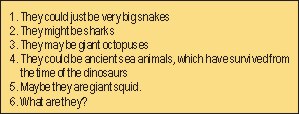|
Education


Question: What animal is over 30 feet long, has a big head, enormous eyes, a mane like a lion, a long neck, a body like a snake and lots of arms like an octopus?
Answer: Nobody knows.
Before you read the text, see if you can match the words with their definitions. Check your answers before moving on to the next exercise.

1. …………… is a green, brown or dark red plant that grows in the sea or on land very close to the sea.
2. A …………… is the long thick hair that grows along the top of a horse's neck or around the face and neck of a lion or other animal.
3. To …………… is to (cause to) decay.
4. A …………… is a sea creature with a long body and ten arms situated around the mouth.
5. A …………… is a very large fish that has sharp teeth and a vertical triangular fin on its back which can sometimes be seen above the water.
6. The …………… of something is (the length of) a straight line that reaches from one point on the edge of a round shape or object, through its centre, to a point on the opposite edge.
7. A …………… is the hard pointed part of a bird's (or some other animal's) mouth.
8. A …………… is a very large sea mammal.
9. An …………… is a sea creature with a soft oval body and eight tentacles arms.
10. The …………… of something is the measurement of something from end to end or along its longest side.
 Before you read the text, look at the headings in the box on the right. Then read the text quickly and try to match the headings to the paragraphs. |
A
Sailors have been telling stories about giant creatures of the sea for hundreds of years. The monsters that sailors and fishermen describe are all slightly different but it's often an animal like a giant snake, at least 30 feet long, with an enormous head and neck. It sometimes actually attacks the ship. Some of these sea monsters turned out to be big pieces of seaweed or wood, but other stories are not so easy to explain. So what can these monsters be?
B
There is an unusual type of shark that is shaped like an eel. It has a frill around its neck, which could look like a lion's mane. The biggest one ever caught was only 25 feet long. Another type of shark, the 'basking shark', can grow to about 40 feet in length. In the 1970s a Japanese fishing boat caught an enormous dead 'monster' with a long neck. Scientists tested some small pieces of the animal and discovered that it was a basking shark. When these sharks die, parts of them rot very quickly, which gives them a very strange shape. However, this doesn't explain stories about living, moving sea monsters.
C
The biggest snake in the world is the anaconda. One was found in the 1940s measuring 35 feet but there are no photographs to prove it. South American Indians tell stories of even bigger ones. The problem with this theory is that the anaconda is native to South America and can't survive in cold water.
D
This is another interesting theory. Scientists all accept that the giant squid really exists but we don't see them very often because they live in deep, cold water. They can be up to 50 feet in length and have the biggest eyes in the animal kingdom - over one-foot in diameter. And there are reports of much bigger ones too. They have a strong mouth like a bird's beak that can cut through steel cables and five pairs of arms, or tentacles. One pair is longer and thinner and is used to catch food. People have seen giant squid attacking whales for food. In the 1960s some Russian sailors reported watching a fight between a whale and a giant squid. Both animals died; the whale was found dead with the squid's arms wrapped around its neck, and the squid's head was found in the whale's stomach. There are also reports of giant squid attacking ships, maybe thinking that they were whales. So stories of giant sea snakes wrapped around ships could actually be one or two arms of a giant squid.
E
Other types of creatures that exist are varieties of octopus with bodies as big as 23 feet around. There are also stories that there may be an unknown variety that grows much, much bigger. An enormous animal was found dead and rotting on a beach in Florida in the 1890s. Parts of it seemed to be huge arms - over 30 feet long. Scientists tested a small part of the body but couldn't agree whether it was a whale or an octopus. The giant octopus has a strong mouth like the giant squid, but only has eight arms. They live at the bottom of the sea and use their arms to move around over the rocks. This explains why we don't see them very often.
F
We know that strange animals lived in the sea during pre-historic times and many of them were very big indeed. They didn't look like fish and they had to come up to the surface of the water to breathe air. Perhaps when the dinosaurs died out, these sea creatures survived and have lived in the oceans ever since. Is that possible? Well maybe it is. In 1938 a strange fish was caught in the Indian Ocean. Scientists eventually identified it as a coelacanth (pronounced 'seel-a-kanth') which everyone thought had died out over 70 million years ago. And another type of coelacanth was found in the 1990s in South East Asia.
So, do any of these explanations convince you? Or do you think that deep down at the bottom of the sea, where we have never explored, there are strange creatures that are still completely unknown to science?
The following statements are about the text. Read the statements and decide whether they are true, or false.
i) Basking sharks can grow up to 40 yards long.
ii) The anaconda snake can grow to 35 feet long.
iii) The giant squid is longer than the anaconda snake.
iv) Both the anaconda and the giant squid like warm waters.
v) The giant octopus is a myth.
vi) The Coelacanth became extinct 70 million years ago.
vii) A Japanese fishing boat caught a huge sea monster in the 1970s.

Copyright
(R) thedailystar.net 2005 |
